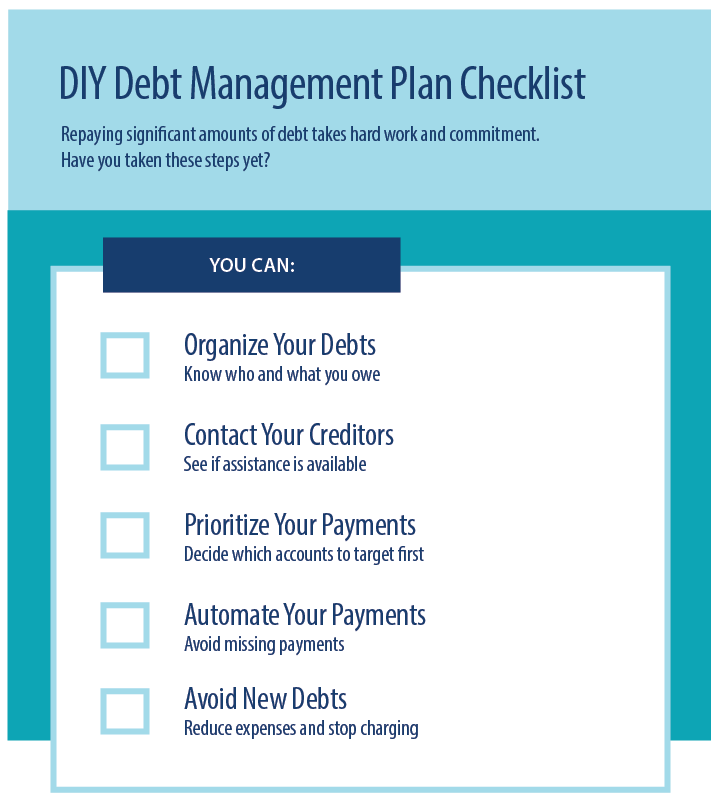Every Little Thing You Required to Learn About Creating an Individualized Debt Monitoring Strategy
In the world of personal financing, creating a customized debt management strategy is often the cornerstone of attaining financial stability and peace of mind. As you navigate the complexities of producing a personalized financial debt monitoring plan, comprehending the intricacies of each action is crucial to your financial success.
Evaluating Your Present Debt Scenario
One should first carry out a thorough assessment of their present financial obligation obligations prior to developing an efficient financial debt monitoring plan. Create an in-depth checklist of each financial obligation, including the complete quantity owed, rate of interest rates, minimum monthly repayments, and due days.
After compiling this info, compute your overall debt-to-income ratio by separating your monthly financial obligation settlements by your month-to-month revenue. This proportion is an essential indication of your capability to manage current debt degrees effectively. Additionally, analyze your credit rating report to recognize any type of errors or inconsistencies that might be impacting your credit report. Recognizing these aspects of your economic scenario will assist you in establishing a customized financial obligation administration strategy tailored to your certain requirements and objectives.
Setting Financial Goals and Targets

When establishing monetary objectives, it is necessary to be specific, measurable, possible, pertinent, and time-bound (CLEVER) For instance, you may set an objective to settle a certain quantity of debt within a specific timespan, such as decreasing your credit card balance by $5,000 in the following twelve month - More Discussion Posted Here. By establishing clear targets such as this, you can track your progress and remain encouraged to achieve your financial obligation administration objectives
In addition, consider prioritizing your financial debts based upon elements such as passion prices, outstanding equilibriums, and settlement terms. By concentrating on high-interest financial obligations first, you can save money in the future and increase your trip toward financial liberty. Bear in mind, each individual's financial scenario is distinct, so customize your goals and targets to fit your specific requirements and scenarios.
Creating a Realistic Budget
Crafting a distinct budget is an essential step in effective financial obligation management and financial planning. A practical spending plan functions as a roadmap for your monetary health and wellness, assisting you track your earnings, expenses, and debt settlements. To produce a sensible budget, start by listing all your income sources. This includes your income, side hustle profits, or any type of various other financial inflows. Next, directory all your fixed expenses such as rent or mortgage, utilities, insurance policy, and funding settlements. Variable expenditures like groceries, home entertainment, and transportation ought to likewise be included. Differentiate in between needs and desires to focus on necessary costs and determine areas where you can cut back.
When setting spending plan restrictions, be truthful with on your own about your investing routines and financial obligations. Allot a section of your revenue towards paying my link off financial debt while guaranteeing you have some funds for cost savings and emergencies. Consistently testimonial and change your spending plan as needed to remain on track with your monetary goals and financial obligation repayment strategy. By sticking to a realistic budget, you can effectively manage your debt and work towards an extra protected monetary future.
Checking Out Financial Debt Repayment Approaches
After developing a sensible spending plan, the following vital action in effective financial obligation monitoring is to explore various financial obligation settlement approaches. One common method is the snowball technique, where you concentrate on repaying the smallest financial obligations first while making minimum settlements on bigger debts. This approach can aid construct energy as you see smaller financial debts being gotten rid of, providing motivation to take on larger ones.
One more method is the avalanche technique, which includes focusing on debts with the highest rate of interest. By targeting high-interest financial debts first, you can reduce the total quantity you pay in rate of interest in time. This technique may be more cost-effective in the lengthy run, although it could take longer to see private financial obligations fully paid off.
Debt loan consolidation is one more choice where you combine multiple debts into a single car loan with a reduced passion rate. This can streamline your repayment procedure and potentially decrease the total passion paid. Nevertheless, it's important to thoroughly think about the costs and terms associated with consolidation to guarantee it's the ideal choice for your economic circumstance.
Surveillance and Readjusting Your Plan

Changing your strategy might entail reapportioning funds to deal with high-interest financial debts first, negotiating with lenders for reduced interest rates or better payment terms, or checking out extra earnings sources to accelerate financial debt settlement. As your financial scenario develops, your financial obligation monitoring strategy must adapt as necessary to continue to be efficient. By staying adaptable and aggressive in monitoring and readjusting your strategy, you can enhance your initiatives in the direction of paying off your financial debts successfully and attaining your economic goals.
Conclusion
In final thought, creating a customized debt administration strategy includes assessing current financial debt, setting monetary goals, developing a practical check budget, exploring payment methods, and tracking and readjusting the strategy as needed. By complying with these actions, people can take control of their economic situation and work towards becoming debt-free. It is essential to stay self-displined Your Domain Name and committed to the plan in order to achieve lasting monetary security.
One should first perform a detailed analysis of their present financial debt commitments prior to formulating an efficient debt administration plan.After establishing a practical budget, the next important step in reliable financial obligation monitoring is to explore numerous debt payment approaches - More Discussion Posted Here.To effectively manage your financial obligation, continuous tracking and change of your financial obligation monitoring strategy are necessary components for lasting monetary security.Changing your strategy may include reapportioning funds to take on high-interest financial debts first, working out with creditors for lower passion rates or better repayment terms, or discovering extra income sources to accelerate debt repayment.In final thought, producing a tailored financial debt administration plan involves analyzing current financial debt, setting financial goals, creating a practical budget, exploring repayment strategies, and monitoring and adjusting the plan as required